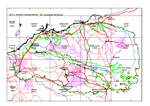Click on images
to enlarge


, BRM 8019, ORIGINAL SCAN, ADJUSTED RICHARD WOODMAN_sml.jpg)
Photographer: B.R. Maslin
, BRM 5277, ORIGINAL SCAN, ADJUSTED RICHARD WOODMAN_sml.jpg)
Photographer: B.R. Maslin
 habit 4, S of Nullagine, BRM photo_sml.jpg)
Adolescent growth habit. Photographer: B.R. Maslin

Non-pendulous growth habit. Photographer: B.R. Maslin
, BRM 8154, ORIGINAL SCAN, ADJUSTED RICHARD WOODMAN_sml.jpg)
Photographer: B.R. Maslin
, SM 629, lab photo by Fiona McCallum ADJUSTED_sml.jpg)
Seed from one herbarium voucher. Scale in mm. Photographer: F. McCallum.

Branches with galls. Photographer: B.R. Maslin

Galls. Photographer: B.R. Maslin
Botanical name
Acacia paraneura Randell, J. Adelaide Bot. Gard. 14: 116, fig. 1H (1992)
Common name
Weeping Mulga
Aboriginal name
Warlun (Kurrama)
Description
Graceful trees 4-10 m tall, with 1 or several main trunks from base, crowns open and often wispy, the ultimate branchlets commonly (but not always) pendulous or sub-pendulous. Bark grey, longitudinally fissured on main trunks. Branchlets normally pendulous or sub-pendulous, silvery white sericeous between the resinous ribs (best observed at extremities). New shoots resinous, with simple hairs intermixed with microscopic, red-brown glandular hairs, the latter very dense but becoming scattered as the shoot expands. Phyllodes terete to sub-terete, (6-) 7-20 (-23) cm long, 0.8-1.2 mm wide, not rigid, straight or shallowly curved or sinuous, appressed silvery-hairy between nerves but becoming glabrous with age, dull green to grey-green; parallel longitudinal nerves numerous and fine; apex not pungent. Gland situated on upper surface of phyllode 4-25 mm above pulvinus, lamina often slightly kinked or bent (and/or slightly swollen) at the gland. Inflorescences simple or rudimentary racemes to 3 mm long; peduncles (4-) 5-12 (-15) mm long, with a mixture of simple, appressed white hairs and red-glandular hairs, often glabrous in fruit; spikes golden, 10-30 mm long. Flowers 5-merous; sepals linear-spathulate, free or almost so. Pods oblong to narrowly oblong, narrowed at base, flat, neither raised over nor constricted between seeds, 2-6 (-9) cm long, 7-12 (-17) mm wide (including wings 1-2.5 mm wide), thinly coriaceous to ±crustaceous, straight, ±obscurely openly reticulately nerved, with sparse or moderately dense, appressed microscopic hairs at maturity (hairs difficult to see without magnification). Seeds oblique to transverse, obloid-ellipsoid to ovoid, 4-7 mm long, 2.5-3.5 mm wide, flattened, shiny, brown; funicle folded below a relatively small, creamy white aril.
Characteristic features
Graceful trees with open and often wispy crowns, the ultimate branchlets commonly pendulous or sub-pendulous. New shoots densely clothed with red-brown glandular resin hairs when first initiated. Phyllodes normally terete, long (mostly 7-20 cm) and flexible, often slightly kinked or bent (and/or slightly swollen) at the gland which is 4-25 mm above the pulvinus, grey-green, finely multi-striate. Pods oblong to narrowly oblong, narrowed at base, flat, straight, thinly coriaceous to ±crustaceous, openly reticulately nerved, brown, with sparse or moderately dense, appressed microscopic hairs at maturity (hairs difficult to see without magnification).
Distribution and ecology
Occurs in the arid zone where it extends from the Pilbara region in northwest Western Australia eastwards through southern Northern Territory and north-eastern South Australia, with outliers in central Queensland. In the Pilbara A. paraneura extends from the central Hamersley Range at Tom Price (where it is uncommon) to east of Ethel Creek Station (where it is common). In the Pilbara Weeping Mulga typically grows with other forms of A. aneura in a woodland - low woodland community over scrubs (Eremophila species) and soft hummock and tussock grasses on alluvial plains and sheet flood hardpan plains although in the central Hamersley Range it grows on stony plains with loamy soils under a surface mantle of pebbles in open low Mulga woodlands and shrublands. In the Ethel Creek Station - Jigalong area Weeping Mulga is also common on the banks and washes of drainage lines where is grows in heavy loam and gilgai clay soils with A. aneura , A. catenulata and A. distans.
Flowering and fruiting period
Flowering and fruiting appears to be influenced by the timing and intensity of rainfall. Over its geographic range the peak flowering appears to be in about June and July, however, flowering has also been recorded for January, March, May, August and October. Pods with mature seeds have been collected from mid-September to early November.
Variation
Although plants of this species normally have pendulous phyllodes and pendulous to sub-pendulous branches there are occasional individuals where this weeping habit does not occur.
Taxonomy
Acacia paraneura is a member of the taxonomically complex A. aneura (Mulga) group of species which is currently under review. Judging from field observations it is possible that in a few Pilbara populations A. paraneura hybridizes with other taxa of the Mulga group, however, this presumed hybridity has not yet been confirmed.
Affinities
The distinctive growth form, the long, terete to sub-terete phyllodes which are often slightly kinked, bent or swollen at the gland (which is removed from the pulvinus) and the broad, clearly winged pods serve to distinguish A. paraneura from its closest relative, A. aneura.
Notes
This species has horticultural potential on account of its attractive growth form. However, while it is likely to be reasonably long-lived Weeping Mulga is also likely to have a relatively slow growth rate. Furthermore, plants of this species are often inhabited by gall-producing thrips and this could also constrain its use as a horticultural plant if left untreated.
Like typical Mulga the dense wood from A. paraneura was used by indigenous peoples to make weapons and hunting tools; the seed and immature pods were eaten and the roots used as fire sticks.
Conservation status
Not considered rare or endangered.
Origin of name
The botanical name is derived from the Greek para (near) and aneura (without nerves) reflecting its affinities to A. aneura (common Mulga).
